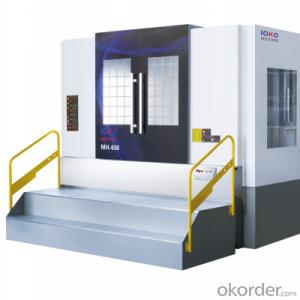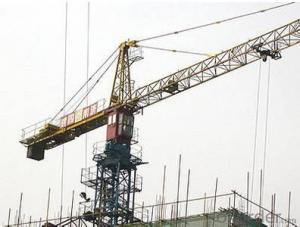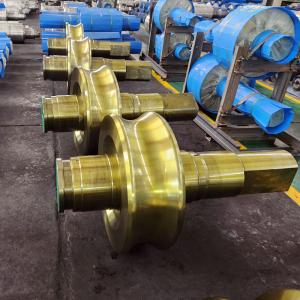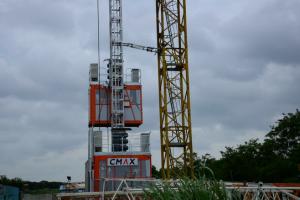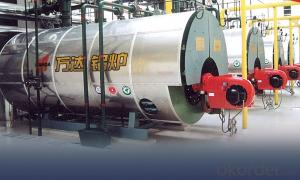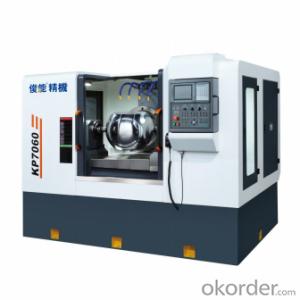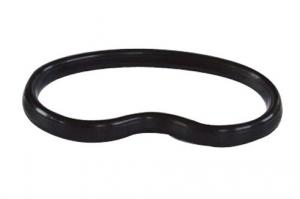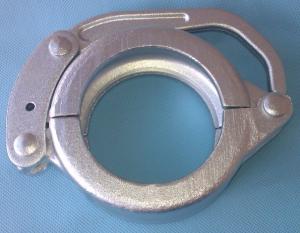Concrete Pump Putzmeister Seal Piston DN180 - DN230
- Loading Port:
- China Main Port
- Payment Terms:
- TT OR LC
- Min Order Qty:
- -
- Supply Capability:
- -
OKorder Service Pledge
Quality Product, Order Online Tracking, Timely Delivery
OKorder Financial Service
Credit Rating, Credit Services, Credit Purchasing
You Might Also Like
Brand: Schwing, Putzmeister, Sany,Zoomlion, IHI, Kyokuto, Sermac
Other products:
1) ST52 steel pipe, elbow, reducer
2) Wear-resisting board and Cuts ink
3) Coupling and seal ring for Putzmeister,Schwing, Sany
4) Rubber hose
5) Cleaning series and others
- Q:How do I determine the correct temperature ratings for concrete pump spare parts?
- To determine the correct temperature ratings for concrete pump spare parts, you should refer to the manufacturer's guidelines or specifications. These documents usually provide information on the recommended temperature range within which the parts can function effectively and safely. It is essential to follow these guidelines to ensure the longevity and performance of the spare parts in your concrete pump system.
- Q:How do I maintain and clean concrete pump spare parts?
- To ensure the long life and smooth operation of concrete pump spare parts, it is crucial to maintain and clean them. Follow these steps to accomplish this: 1. Conduct Routine Inspections: Begin by carefully examining the spare parts for signs of wear, cracks, or damage. This step is essential for identifying potential issues that require immediate attention. 2. Apply Lubrication: To minimize friction and prevent seizing, apply lubricant to moving parts like bearings, pistons, and cylinders. 3. Thoroughly Clean: Employ a high-pressure washer or hose to thoroughly clean the spare parts. Eliminate any accumulated dirt, debris, or concrete residue, paying particular attention to hard-to-reach areas. 4. Prevent Rust: Guard metal parts against corrosion by applying a rust preventive coating. This step is especially important if the spare parts are exposed to moisture or inclement weather conditions. 5. Proper Storage: Store the spare parts in a clean and dry location to shield them from moisture, dust, and other contaminants. Avoid directly stacking them on the ground to prevent damage. 6. Regular Maintenance: Establish a maintenance schedule and adhere to it. Adhere to the manufacturer's guidelines for routine tasks such as replacing filters, checking oil levels, and inspecting seals. Regular maintenance aids in the detection of potential issues before they escalate into major problems. 7. Seek Professional Assistance: If you are uncertain about how to maintain or clean specific spare parts, it is advisable to seek professional assistance. Concrete pump spare parts are intricate and necessitate expert handling. Remember, proper maintenance and regular cleaning of concrete pump spare parts not only prolong their lifespan but also enhance the overall performance and efficiency of your concrete pump.
- Q:What is the function of a concrete pump control lever?
- The function of a concrete pump control lever is to control the flow and direction of the concrete being pumped. It allows the operator to start and stop the pump, adjust the speed of the pump, and control the placement and placement speed of the concrete. The control lever also enables the operator to switch between different pumping modes, such as pumping vertically or horizontally, and adjust the pressure of the concrete being pumped. Overall, the control lever is essential in ensuring accurate and efficient concrete pumping operations.
- Q:What are the different types of concrete pump hopper agitator motors?
- There are generally two types of concrete pump hopper agitator motors: electric motors and hydraulic motors. Electric motors are powered by electricity and are commonly used in smaller and portable concrete pumps. Hydraulic motors, on the other hand, are driven by hydraulic power generated by the concrete pump itself and are typically used in larger and stationary concrete pumps.
- Q:Are there any specific guidelines for the installation of pipe or hose assemblies in concrete pump spare parts?
- Yes, there are specific guidelines for the installation of pipe or hose assemblies in concrete pump spare parts. These guidelines ensure proper installation techniques are followed to ensure the assemblies are securely and correctly installed. It is important to consult the manufacturer's instructions and adhere to industry standards to ensure optimal performance and safety of the concrete pump spare parts.
- Q:What is the function of a concrete pump hopper grate pin?
- The function of a concrete pump hopper grate pin is to securely hold the grate in place, preventing it from shifting or becoming dislodged during the concrete pumping process.
- Q:How can one identify the correct part number for a specific concrete pump spare part?
- To identify the correct part number for a specific concrete pump spare part, one can start by examining the equipment's manual or documentation. These resources usually provide detailed information about the pump's components, including part numbers. If the manual is unavailable, contacting the manufacturer or a reputable supplier of concrete pump parts can also be helpful. Providing them with the necessary details, such as the make, model, and serial number of the pump, will assist them in identifying and providing the correct part number for the required spare part.
- Q:How often should hopper cylinder seals be replaced in a concrete pump?
- The replacement frequency of hopper cylinder seals in a concrete pump varies depending on factors such as seal quality, usage intensity, and maintenance practices. It is recommended to regularly inspect hopper cylinder seals for any signs of wear or damage, and if cracks, tears, or leaks are visible, immediate replacement is advised to prevent further damage to the concrete pump. In general, hopper cylinder seals can last for several months to a couple of years, depending on the aforementioned factors. However, it is crucial to establish a preventive maintenance plan and regularly monitor the seals' condition to ensure optimal performance and minimize downtime. Furthermore, consulting the manufacturer's guidelines or seeking advice from a professional concrete pump technician is advisable to determine the specific replacement interval for hopper cylinder seals based on the pump model, usage patterns, and environmental conditions.
- Q:How do I properly maintain and replace rubber pistons in concrete pump spare parts?
- To guarantee efficient pump operation and extend equipment lifespan, it is imperative to maintain and replace rubber pistons in concrete pump spare parts. Below are guidelines for proper maintenance and replacement: 1. Regularly Inspect: Regularly examine the rubber pistons to detect any wear or damage. Look for visible signs of deterioration such as cracks, tears, or other forms of degradation. 2. Thorough Cleaning: Prior to replacing the rubber pistons, thoroughly cleanse the surrounding area. Remove any dirt, debris, or concrete residue that may be present. This will prevent contamination and ensure a proper fit for the new pistons. 3. Adequate Lubrication: Apply a suitable lubricant to the rubber pistons to guarantee smooth operation and reduce friction. This will prolong the pistons' lifespan and prevent premature wear. 4. Proper Installation: When replacing the rubber pistons, ensure correct installation in accordance with the manufacturer's instructions. Utilize appropriate tools and techniques to avoid damaging the pistons or other pump components. 5. High-Quality Replacement Parts: Always opt for reputable suppliers and utilize high-quality replacement rubber pistons. Inferior quality pistons may not perform optimally and could result in frequent replacements or pump damage. 6. Regular Maintenance: Establish a regular maintenance schedule for your concrete pump, including the rubber pistons. This may involve cleaning, lubrication, and inspection of the pistons to identify potential wear or damage before they become major issues. 7. Training and Expertise: Ensure that the individual responsible for maintaining and replacing the rubber pistons possesses the necessary training and expertise. This will ensure proper execution of the task and minimize the risk of pump damage or personnel injury. By adhering to these guidelines, you can effectively maintain and replace rubber pistons in concrete pump spare parts, thereby ensuring optimal equipment performance and longevity.
- Q:Are there any environmental considerations in the production of concrete pump spare parts?
- Yes, there are environmental considerations in the production of concrete pump spare parts. Concrete production itself is known to have a significant environmental impact due to the extraction and processing of raw materials, as well as the energy consumption and carbon emissions associated with its production. Therefore, the production of concrete pump spare parts should prioritize eco-friendly manufacturing processes, use recycled materials where possible, and minimize waste generation. Additionally, the selection of suppliers and transportation methods should aim to reduce the carbon footprint of the supply chain.
1. Manufacturer Overview |
|
|---|---|
| Location | |
| Year Established | |
| Annual Output Value | |
| Main Markets | |
| Company Certifications | |
2. Manufacturer Certificates |
|
|---|---|
| a) Certification Name | |
| Range | |
| Reference | |
| Validity Period | |
3. Manufacturer Capability |
|
|---|---|
| a)Trade Capacity | |
| Nearest Port | |
| Export Percentage | |
| No.of Employees in Trade Department | |
| Language Spoken: | |
| b)Factory Information | |
| Factory Size: | |
| No. of Production Lines | |
| Contract Manufacturing | |
| Product Price Range | |
Send your message to us
Concrete Pump Putzmeister Seal Piston DN180 - DN230
- Loading Port:
- China Main Port
- Payment Terms:
- TT OR LC
- Min Order Qty:
- -
- Supply Capability:
- -
OKorder Service Pledge
Quality Product, Order Online Tracking, Timely Delivery
OKorder Financial Service
Credit Rating, Credit Services, Credit Purchasing
Similar products
New products
Hot products
Related keywords
















